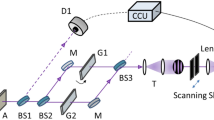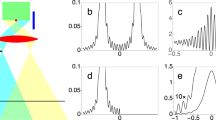Abstract
To illustrate the quantum mechanical principle of complementarity, Bohr1 described an interferometer with a microscopic slit that records the particle's path. Recoil of the quantum slit causes it to become entangled with the particle, resulting in a kind of Einstein–Podolsky–Rosen pair2. As the motion of the slit can be observed, the ambiguity of the particle's trajectory is lifted, suppressing interference effects. In contrast, the state of a sufficiently massive slit does not depend on the particle's path; hence, interference fringes are visible. Although many experiments illustrating various aspects of complementarity have been proposed3,4,5,6,7,8,9 and realized10,11,12,13,14,15,16,17,18, none has addressed the quantum–classical limit in the design of the interferometer. Here we report an experimental investigation of complementarity using an interferometer in which the properties of one of the beam-splitting elements can be tuned continuously from being effectively microscopic to macroscopic. Following a recent proposal19, we use an atomic double-pulse Ramsey interferometer20, in which microwave pulses act as beam-splitters for the quantum states of the atoms. One of the pulses is a coherent field stored in a cavity, comprising a small, adjustable mean photon number. The visibility of the interference fringes in the final atomic state probability increases with this photon number, illustrating the quantum to classical transition.
This is a preview of subscription content, access via your institution
Access options
Subscribe to this journal
Receive 51 print issues and online access
$199.00 per year
only $3.90 per issue
Buy this article
- Purchase on Springer Link
- Instant access to full article PDF
Prices may be subject to local taxes which are calculated during checkout




Similar content being viewed by others
References
Bohr, N. in Albert Einstein: Philosopher Scientist (ed. Schilpp, P. A.) 200–241 (Library of Living Philosophers, Evanston, 1949); reprinted in Quantum Theory and Measurement (eds Wheeler, J. A. & Zurek, W. H.) 9–49 (Princeton Univ. Press, Princeton, 1983).
Einstein, A., Podolsky, B. & Rosen, N. Can quantum mechanical description of physical reality be considered complete? Phys. Rev. 47, 777–780 (1935).
Scully, M. O. & Zubairy, M. S. Quantum Optics (Cambridge Univ. Press, Cambridge, UK, 1997).
Scully, M. O., Englert, B. G. & Walther, H. Quantum optical tests of complementarity. Nature 351, 111–116 (1991).
Haroche, S., Brune, M. & Raimond, J. M. Manipulations of optical fields by atomic interferometry: quantum variations on a theme by Young. Appl. Phys. B 54, 355–365 (1992).
Englert, B. G. Fringe visibility and which-way information: an inequality. Phys. Rev. Lett. 77, 2154–2157 (1996).
Englert, B. G., Scully, M. O. & Walther, H. Complementarity and uncertainty. Nature 375, 367 (1995).
Storey, P., Tan, S., Collet, M. & Walls, D. Complementarity and uncertainty. Nature 375, 368 (1995).
Wiseman, H. et al. Non local momentum transfer in welcher Weg measurements. Phys. Rev. A 56, 55–75 (1997).
Badurek, G., Rausch, H. & Tuppinger, D. Neutron interferometric double resonance experiments. Phys. Rev. A 34, 2600–2608 (1985).
Grangier, P., Roger, G. & Aspect, A. Experimental evidence for photon anticorrelation effect on a beam splitter: a new light on single-photon interference. Europhys. Lett. 1, 173–179 (1986).
Pfau, T. et al. Loss of spatial coherence by a single spontaneous emission. Phys. Rev. Lett. 73, 1223–1227 (1994).
Chapman, M. S. et al. Photon scattering from atoms in an atom interferometer: coherence lost and regained. Phys. Rev. Lett. 75, 3783–3787 (1995).
Eichman, U. et al. Young's interference experiment with light scattered from two atoms. Phys. Rev. Lett. 70, 2359–2362 (1993).
Dürr, S., Nonn, T. & Rempe, G. Origin of quantum-mechanical complementarity probed by a “which way” experiment in an atom interferometer. Nature 395, 33–37 (1998).
Dürr, S., Nonn, T. & Rempe, G. Fringe visibility and which-way information in an atom interferometer. Phys. Rev. Lett. 81, 5705–5709 (1998).
Herzog, T. J., Kwiat, P. G., Weinfurter, H. & Zeilinger, A. Complementarity and the quantum eraser. Phys. Rev. Lett. 75, 3034–3037 (1995).
Bucks, E., Schuster, R., Heiblum, M., Mahalu, D. & Umansky, V. Dephasing in electron interference by a “which-path” detector. Nature 391, 871–874 (1998).
Zheng, S. B. A simplified scheme for testing complementarity and realising quantum eraser. Opt. Comm. 173, 265–267 (2000).
Ramsey, N. Molecular Beams (Oxford Univ. Press, Oxford, UK, 1985).
Nogues, G. et al. Seeing a single photon without destroying it. Nature 400, 239–242 (1999).
Rauschenbeutel, A. et al. Coherent operation of a tunable quantum phase gate. Phys. Rev. Lett. 83, 5166–5169 (1999).
Brune, M. et al. From Lamb shift to light shifts: vacuum and sub-photon cavity fields measured by atomic interferometry. Phys. Rev. Lett. 72, 3339–3342 (1994).
Brune, M. et al. Quantum Rabi oscillation: a direct test of field quantization in a cavity. Phys. Rev. Lett. 76, 1800–1803 (1996).
Haroche, S. & Raimond, J. M. in Cavity Quantum Electrodynamics (ed. Berman, P.) 123–170 (Academic, New York, 1992).
Kim, J. I. et al. Classical behaviours with small quantum numbers: the physics of Ramsey interferometry of Rydberg atoms. Phys. Rev. Lett. 82, 4737–4740 (1999).
Gerry, C. C. Complementarity and quantum erasure with dispersive atom-field interaction. Phys. Rev. A 53, 1179–1182 (1996).
Brune, M. et al. Observing the progressive decoherence of the meter in a quantum measurement. Phys. Rev. Lett. 77, 4887–4890 (1996).
Scully, M. O. & Srühl, K. Quantum eraser: a proposed photon correlation experiment concerning observation and “delayed choice” in quantum mechanics. Phys. Rev. A 25, 2208–2213 (1982).
Kwiat, P. G., Steinberg, A. M. & Chiao, R. Y. Observation of a “quantum eraser”: a revival of coherence in a 2-photon interference experiment. Phys. Rev. A 45, 7729–7739 (1992).
Acknowledgements
Laboratoire Kastler Brossel is Unité Mixte de Recherches of Ecole Normale Supérieure, Université P. et M. Curie and Centre National de la Recherche Scientifique. This work was supported by the Commission of the European Community and by the Japan Science and Technology Corporation (International Cooperative Research Project, Quantum Entanglement Project).
Author information
Authors and Affiliations
Corresponding author
Rights and permissions
About this article
Cite this article
Bertet, P., Osnaghi, S., Rauschenbeutel, A. et al. A complementarity experiment with an interferometer at the quantum–classical boundary. Nature 411, 166–170 (2001). https://doi.org/10.1038/35075517
Received:
Accepted:
Issue Date:
DOI: https://doi.org/10.1038/35075517
This article is cited by
-
Entanglement-interference complementarity and experimental demonstration in a superconducting circuit
npj Quantum Information (2023)
-
A Unified Explanation of Some Quantum Phenomena
International Journal of Theoretical Physics (2023)
-
The origin of anticorrelation for photon bunching on a beam splitter
Scientific Reports (2020)
-
From cavity to circuit quantum electrodynamics
Nature Physics (2020)
-
Statistical and strict momentum conservation
International Journal of Theoretical Physics (2020)
Comments
By submitting a comment you agree to abide by our Terms and Community Guidelines. If you find something abusive or that does not comply with our terms or guidelines please flag it as inappropriate.



